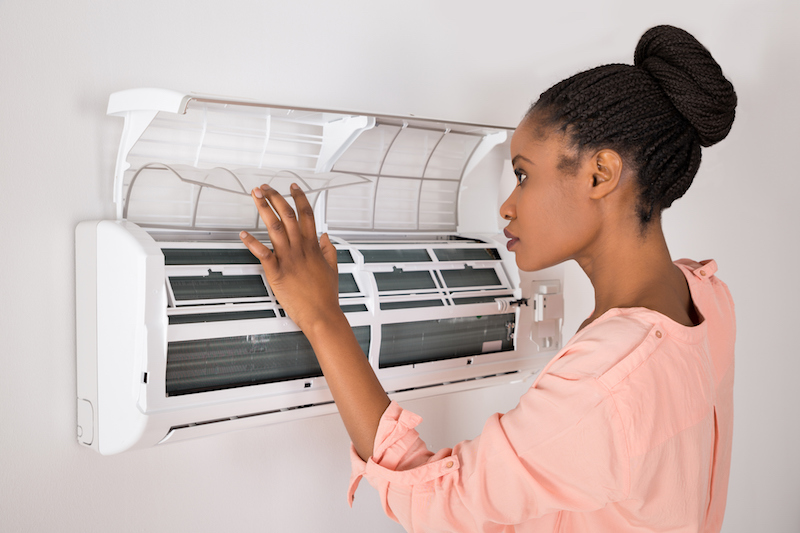
You shouldn’t have to compromise on comfort or spend a lot to keep your house at the right setting during the summer.
But what is the ideal temperature, exactly? We discuss advice from energy specialists so you can select the best temperature for your residence.
Here’s what we suggest for the most energy-efficient setting for air conditioning in Hendersonville.
Recommended Thermostat Settings for Summer
Most people find setting the thermostat at 72-73 degrees provides ideal comfort. However, if there’s a sizeable difference between your interior and outside warmth, your electricity expenses will be greater.
These are our suggestions based on the U.S. Department of Energy (DOE) and ENERGY STAR®.
While at home: 78 degrees. While that appears warm, there are ways you can keep your home pleasant without having the air conditioning running constantly.
Keeping windows and curtains down during the day keeps cold air where it should be—inside. Some window coverings, like honeycomb shades or plantation shutters, are made to offer added insulation and enhanced energy conservation.
If you have ceiling fans in your home, the DOE says you can increase thermostat temps about 4 degrees warmer without giving up comfort. That’s since they refresh through a windchill effect. Because they cool people, not rooms, turn them off when you exit a room.
If 78 degrees still feels too hot on the surface, try doing a trial for approximately a week. Start by upping your setting to 78 degrees while you’re at your residence. Then, gradually turn it down while using the ideas above. You might be astonished at how refreshed you feel at a higher temperature setting.
While away: 88 degrees. There’s no reason to keep the air conditioning on all day while your home is unoccupied. Moving the temp 7–10 degrees hotter can save you as much as 5–15% on your air conditioning costs, according to the DOE.
When you arrive home, don’t be tempted to switch your thermostat below 78 to cool your home faster. This isn’t productive and often produces a higher cooling bill.
A programmable thermostat is a helpful method to keep your temperature controlled, but you need to set programs. If you don’t use programs, you might forget to raise the set temperature when you take off.
If you want a convenient fix, think over installing a smart thermostat. This thermostat links with your phone, so it realizes when you’re at your house and when you’re out. Then it intuitively modifies temperature settings for the best savings. How much exactly? Typically $180 annually on heating and cooling, according to ENERGY STAR.
Another advantage of getting a smart thermostat? You can use your phone to watch and regulate temperature settings from almost anywhere.
While sleeping: Around 70 degrees. While ENERGY STAR suggests 82 degrees, that might be unpleasant for the majority of families. Many people sleep better when their bedroom is chilled, so that’s why the National Sleep Foundation suggests 60–67 degrees. But that might be too cool, based on your clothing and blanket preference.
We advise following a similar test over a week, moving your temp higher and progressively lowering it to determine the right temp for your house. On cool nights, you may find keeping windows open at night and relying on a ceiling fan is a better idea than using the air conditioning.
More Methods to Save Energy During Hot Weather
There are additional methods you can save money on utility bills throughout the summer.
- Buy an energy-efficient air conditioning system. Central air conditioners only last about 12–15 years and lose efficiency as they become older. A new air conditioner can keep your house cooler while keeping electrical bills small.
- Book annual air conditioner tune-ups. Annual air conditioner maintenance keeps your system running like it should and may help it work at better efficiency. It could also help lengthen its life span, since it helps professionals to spot small problems before they lead to a major meltdown.
- Replace air filters regularly. Read manufacturer instructions for switching your air filter. A clogged filter can result in your system short cycling, or turn on and off too frequently, and drive up your electrical.
- Measure attic insulation levels. Just about 90% of residences in the United States don’t have proper insulation, according to the Insulation Institute. The majority of southern climates require 13–14” of attic insulation, while northern climates need 16–18”.
- Have your ductwork examined. Ductwork that has separated over time can leak conditioned air into your attic, walls or crawl space. This can create big comfort problems in your home, like hot and cold spots.
- Seal openings, doors and windows. Keep humid air in its place by closing cracks. You can also caulk or weather strip doors to seal more conditioned air indoors.
Use Less Energy During Warm Weather with Superior Comfort Systems
If you are looking to conserve more energy during warm weather, our Superior Comfort Systems experts can provide assistance. Reach us at 828-202-7025 or contact us online for extra information about our energy-saving cooling solutions.

